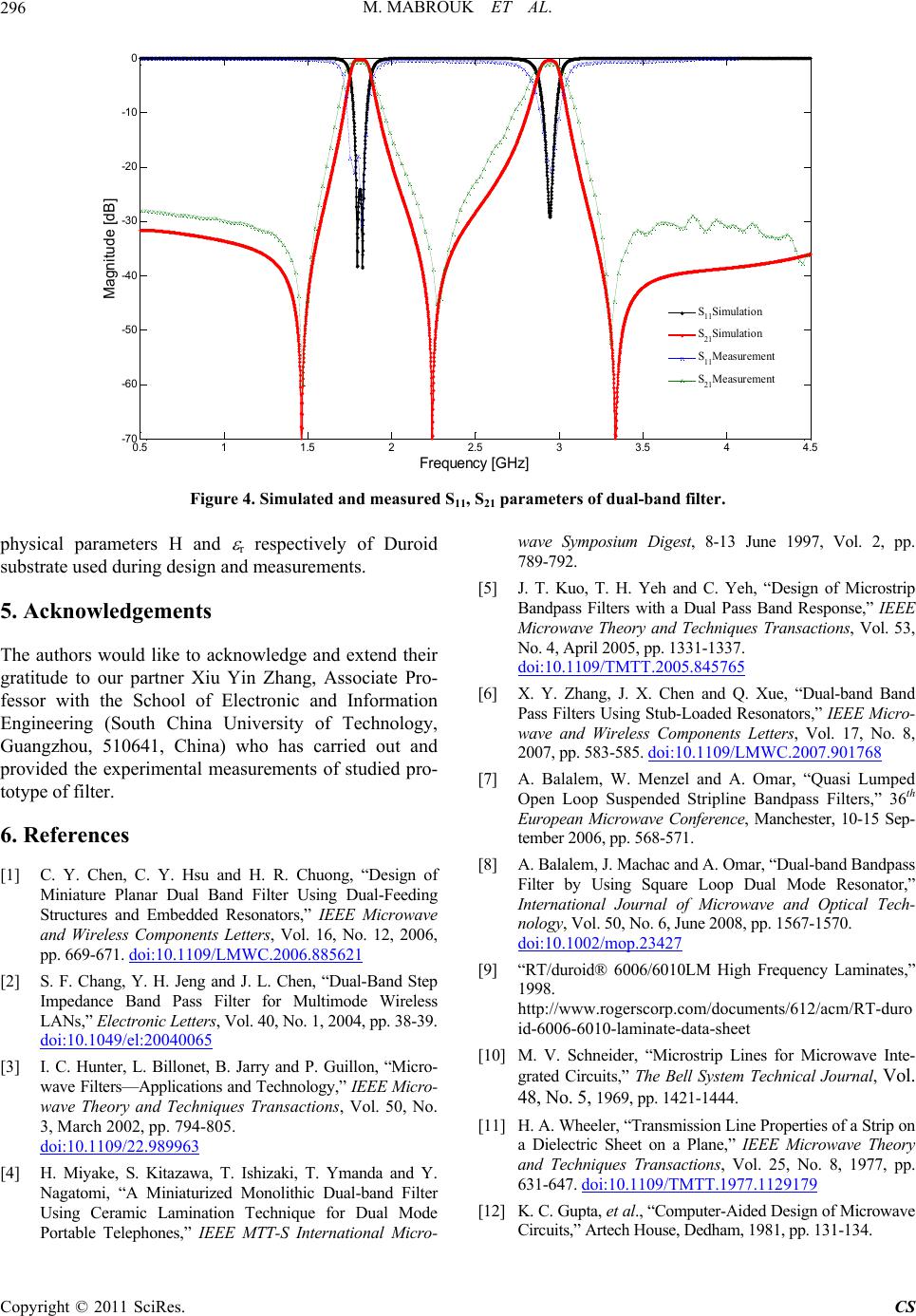
M. MABROUK ET AL.
Copyright © 2011 SciRes. CS
296
0.5 11.5 22.5 33.5 44.5
-70
-60
-50
-40
-30
-20
-10
0
Frequency [GHz]
Magnitude [dB]
S
11
Simulation
S
21
Simulation
S
11
Meas ure me nt
S
21
Meas ure me nt
Figure 4. Simulated and measured S11, S21 parameters of dual-band filter.
physical parameters H and
r respectively of Duroid
substrate used during design and measurements.
5. Acknowledgements
The authors would like to acknowledge and extend their
gratitude to our partner Xiu Yin Zhang, Associate Pro-
fessor with the School of Electronic and Information
Engineering (South China University of Technology,
Guangzhou, 510641, China) who has carried out and
provided the experimental measurements of studied pro-
totype of filter.
6. References
[1] C. Y. Chen, C. Y. Hsu and H. R. Chuong, “Design of
Miniature Planar Dual Band Filter Using Dual-Feeding
Structures and Embedded Resonators,” IEEE Microwave
and Wireless Components Letters, Vol. 16, No. 12, 2006,
pp. 669-671. doi:10.1109/LMWC.2006.885621
[2] S. F. Chang, Y. H. Jeng and J. L. Chen, “Dual-Band Step
Impedance Band Pass Filter for Multimode Wireless
LANs,” Electronic Letters, Vol. 40, No. 1, 2004, pp. 38-39.
doi:10.1049/el:20040065
[3] I. C. Hunter, L. Billonet, B. Jarry and P. Guillon, “Micro-
wave Filters—Applications and T echnology,” IEEE Micro-
wave Theory and Techniques Transactions, Vol. 50, No.
3, March 2002, pp. 794-805.
doi:10.1109/22.989963
[4] H. Miyake, S. Kitazawa, T. Ishizaki, T. Ymanda and Y.
Nagatomi, “A Miniaturized Monolithic Dual-band Filter
Using Ceramic Lamination Technique for Dual Mode
Portable Telephones,” IEEE MTT-S International Micro-
wave Symposium Digest, 8-13 June 1997, Vol. 2, pp.
789-792.
[5] J. T. Kuo, T. H. Yeh and C. Yeh, “Design of Microstrip
Bandpass Filters with a Dual Pass Band Response,” IEEE
Microwave Theory and Techniques Transactions, Vol. 53,
No. 4, April 2005, pp. 1331-1337.
doi:10.1109/TMTT.2005.845765
[6] X. Y. Zhang, J. X. Chen and Q. Xue, “Dual-band Band
Pass Filters Using Stub-Loaded Resonators,” IEEE Micro-
wave and Wireless Components Letters, Vol. 17, No. 8,
2007, pp. 583-585. doi:10.1109/LMWC.2007.901768
[7] A. Balalem, W. Menzel and A. Omar, “Quasi Lumped
Open Loop Suspended Stripline Bandpass Filters,” 36th
European Microwave Conference, Manchester, 10-15 Sep-
tember 2006, pp. 568-571.
[8] A. Balalem, J. Machac and A. Omar, “Dual-band Bandpass
Filter by Using Square Loop Dual Mode Resonator,”
International Journal of Microwave and Optical Tech-
nology, Vol. 50, No. 6, June 2008, pp. 1567-1570.
doi:10.1002/mop.23427
[9] “RT/duroid® 6006/6010LM High Frequency Laminates,”
1998.
http://www.rogerscorp.com/documents/612/acm/RT-duro
id-6006-6010-laminate-data-sheet
[10] M. V. Schneider, “Microstrip Lines for Microwave Inte-
grated Circuits,” The Bell System Technical Journal, Vol.
48, No. 5, 1969, pp. 1421-1444.
[11] H. A. Wheeler, “Transmission Line Properties of a Strip on
a Dielectric Sheet on a Plane,” IEEE Microwave Theory
and Techniques Transactions, Vol. 25, No. 8, 1977, pp.
631-647. doi:10.1109/TMTT.1977.1129179
[12] K. C. Gupta, et al., “Computer-Aided Design of Microwave
Circuits ,” A rtech H ouse, D edh am , 1 981 , pp. 13 1-134 .